Research Highlights
Coral gametogenesis collapse under artificial Light pollution
Inbal Ayalon, Yaeli Rosenberg, Jennifer I.C. Benichou, Celine Luisa D. Campos, Sherry Lyn G. Sayco, Michael Angelou L. Nada, Jake Ivan P. Baquiran, Charlon A. Ligson, Dror Avisar, Cecilia Conaco, Helga U. Kuechly, Christopher C.M. Kyba, Patrick C. Cabaitan & Oren Levy
Link: https://doi.org/10.1016/j.cub.2020.10.039
|
Artificial light at night (ALAN) can have negative impacts on the health of humans and ecosystems. Marine organisms, including coral reefs in particular, rely on the natural light cycles of sunlight and moonlight to regulate various physiological, biological, and behavioral processes. Here, we demonstrate that light pollution caused delayed gametogenesis and unsynchronized gamete release in two coral species, Acropora millepora and Acropora digitifera, from the Indo-Pacific Ocean. Given the urbanization along major coasts, light pollution could thus further threaten coral communities’ populations, which are already under severe degradation. A worldwide-modeled light pollution impact assessment is provided, which can help incorporate an important variable in coral reef conservation planning.
|
Rapid onsets of warming events trigger mass mortality of coral reef fish
Prof. Amatzia Genin, Liraz Levy, Galit Sharon, Dionysios E. Raitsos, and Arik Diamant
Link: https://www.pnas.org/content/early/2020/09/15/2009748117
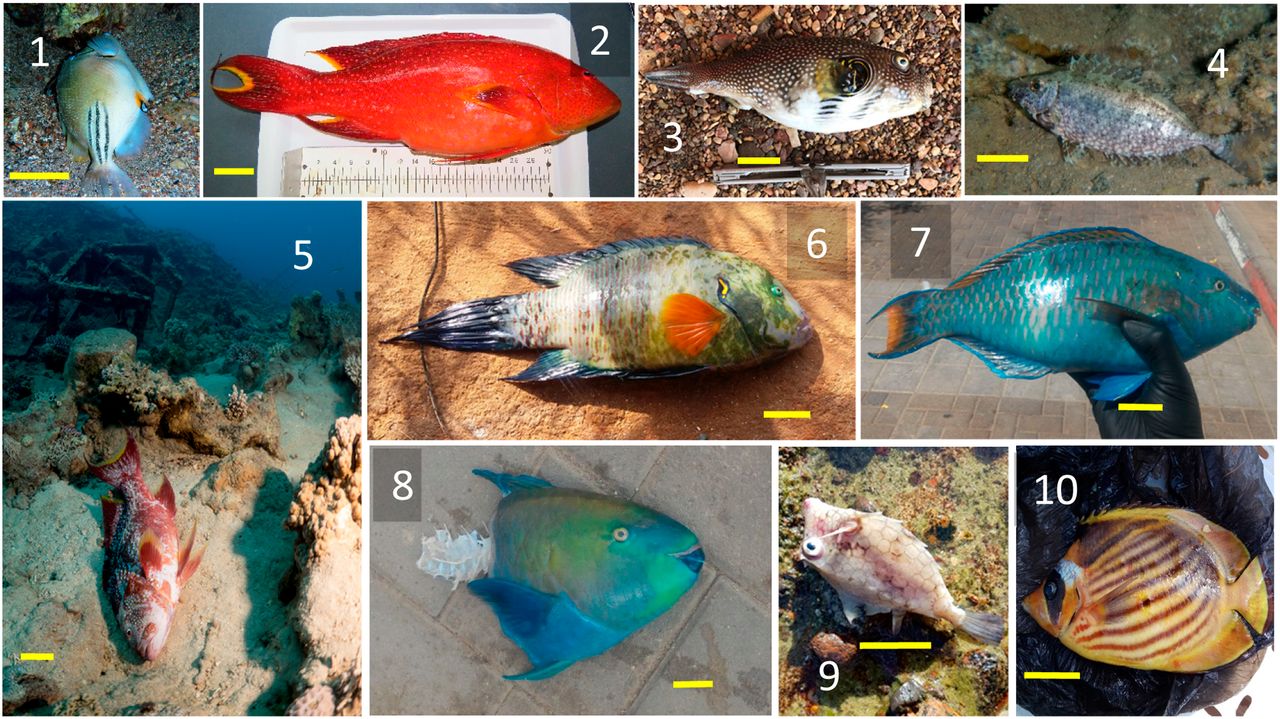
Our study reveals a hitherto overlooked ecological threat of climate change. Studies of warming events in the ocean have typically focused on the events’ maximum temperature and duration as the cause of devastating disturbances in coral reefs, kelp forests, and rocky shores. In this study, however, we found that the rate of onset (Ronset), rather than the peak, was the likely trigger of mass mortality of coral reef fishes in the Red Sea. Following a steep rise in water temperature (4.2 °C in 2.5 d), thermally stressed fish belonging to dozens of species became fatally infected by Streptococcus iniae. Piscivores and benthivores were disproportionately impacted whereas zooplanktivores were spared. Mortality rates peaked 2 wk later, coinciding with a second warming event with extreme Ronset. The epizootic lasted ∼2 mo, extending beyond the warming events through the consumption of pathogen-laden carcasses by uninfected fish. The warming was widespread, with an evident decline in wind speed, barometric pressure, and latent heat flux. A reassessment of past reports suggests that steep Ronset was also the probable trigger of mass mortalities of wild fish elsewhere. If the ongoing increase in the frequency and intensity of marine heat waves is associated with a corresponding increase in the frequency of extreme Ronset, calamities inflicted on coral reefs by the warming oceans may extend far beyond coral bleaching.
|
Pelagic fish predation is stronger at temperate latitudes than near the equator
Marius Roesti, Daniel N. Anstett, Benjamin G. Freeman, Julie A. Lee-Yaw, Dolph Schluter, Louise Chavarie, Jonathan Rolland & Roi Holzman

Species interactions are widely thought to be strongest in the tropics, potentially contributing to the greater number of species at lower latitudes. Yet, empirical tests of this “biotic interactions” hypothesis remain limited and often provide mixed results. Here, we analyze 55 years of catch per unit effort data from pelagic longline fisheries to estimate the strength of predation exerted by large predatory fish in the world’s oceans. We test two central tenets of the biotic interactions hypothesis: that predation is (1) strongest near the equator, and (2) positively correlated with species richness. Counter to these predictions, we find that predation is (1) strongest in or near the temperate zone and (2) negatively correlated with oceanic fish species richness. These patterns suggest that, at least for pelagic fish predation, common assumptions about the latitudinal distribution of species interactions do not apply, thereby challenging a leading explanation for the latitudinal gradient in species diversity.
Link to article:
https://www.nature.com/articles/s41467-020-15335-4
PDF version:
https://iui-eilat.huji.ac.il/uploaded/Research/2020 Roesti et al Pelagic fish predation is stronger at temperate latitudes than near the equator.pdf
|
Seasonal flux patterns of planktonic foraminifera in a deep, oligotrophic, marginal sea: Sediment trap time series from the Gulf of Aqaba, northern Red Sea
Natalie Chernihovskya,b, Adi Torfsteina,b and Ahuva Almogi-Labinc
a Institute of Earth Sciences, The Hebrew University of Jerusalem
b Interuniversity Institute for Marine Sciences in Eilat
c Geological Survey of Israel, Jerusalem

Annual and interannual planktonic foraminifera (PF) fluxes, species assemblage composition, vertical distribution (0–600 m) and shell-size-distribution (63–125, 125–500, 500–1000 µm) were characterized in the marginal oligotrophic Gulf of Aqaba (GOA), northern Red Sea, between January 2014 and February 2016 using a monthly resolved sediment trap time series.
PF fluxes in the GOA demonstrate strong seasonality, with low values observed during summer months, gradually increasing during the autumn-winter. This increase is coeval with decreasing sea-surface temperatures and deepening of the mixed layer depth in the GOA that drives the admixing of nutrient-replete subsurface waters into the mixed layer. This in turn, triggers an increase in primary productivity, expressed by enhanced chlorophyll-a concentrations.
Spinose species constitute the majority of the PF assemblage. The dominant shell size-fraction is between 63 and 125 µm (~86% of the total flux), which has generally been overlooked in previous studies, resulting in a significant knowledge gap related to the neanic stages and the small-adult-size PF. Indeed, the 63–125 µm size-fraction is dominated by the smallest species Turborotalita clarkei (36–92% of this size fraction). The 125–500 µm size-fraction (~13%) is dominated by the species Globigerinoides ruber, while less than 1% of the shells are in the range of 500–1000 µm, dominated by Orbulina universa.
Over the last few decades, the already low number of PF species decreased in the GOA from 13 to 10, including the disappearance of Trilobatus sacculifer, the most common species in the GOA during the 1970s. This finding could reflect the sensitivity of the geographic location of the GOA, at the edge of a > 2000 km transect that begins in the productive Arabian Sea, and spans across the Red Sea, where a gradual decrease in nutrient availability and increase in surface salinity imposes a corresponding decrease in PF species richness, abundances and diversity. Thus, the northern GOA is an extreme case of an oligotrophic system whose ecosystem is already pre-screened by the Red Sea transect. Combined with previous episodes of Trilobatus sacculifer disappearance identified in downcore records in the Red Sea, we conclude that the change in the PF community over recent decades is probably not the result of local eutrophication processes, as has been suggested in recent studies, but rather, more likely reflects environmental changes on a larger regional to global scale.
Deep Sea Res. I (2018)
|
Can mesophotic reefs replenish shallow reefs? Reduced coral reproductive performance casts a doubt
Tom Shlesinger1,3, Mila Grinblat1, Hanna Rapuano1, Tal Amit1,2 and Yossi Loya1
1Faculty of Life Sciences, Tel Aviv University
2School of Marine Sciences, Ruppin Academic Center
3The Interuniversity Institute for Marine Sciences in Eilat

Mesophotic coral ecosystems (i.e., deep coral reefs at 30–120 m depth) appear to be thriving while many shallow reefs in the world are declining. Amid efforts to understand and manage their decline, it was suggested that mesophotic reefs might serve as natural refuges and a possible source of propagules for the shallow reefs. However, our knowledge of how reproductive performance of corals alters with depth is sparse. Here, we present a comprehensive study of the reproductive phenology, fecundity, and abundance of seven reef‐building conspecific corals in shallow and mesophotic habitats. Significant differences were found in the synchrony and timing of gametogenesis and spawning between shallow and mesophotic coral populations. Thus, mesophotic populations exhibited delayed or protracted spawning events, which led to spawning of the mesophotic colonies in large proportions at times where the shallow ones had long been depleted of reproductive material. All species investigated demonstrated a substantial reduction in fecundity and/or oocyte sizes at mesophotic depths (40–60 m). Two species (Seriatopora hystrix and Galaxea fascicularis) displayed a reduction in both fecundity and oocyte size at mesophotic depths. Turbinaria reniformis had only reduced fecundity and Acropora squarrosa and Acropora valida only reduced oocyte size. In Montipora verrucosa, reduced fecundity was found during one annual reproductive season while, in the following year, only reduced oocyte size was found. In contrast, reduced oocyte size in mesophotic populations of Acropora squarrosa was consistent along three studied years. One species, Acropora pharaonis, was found to be infertile at mesophotic depths along two studied years. This indicates that reproductive performance decreases with depth; and that although some species are capable of reproducing at mesophotic depths, their contribution to the replenishment of shallow reefs may be inconsequential. Reduced reproductive performance with depth, combined with the possible narrower tolerance to environmental factors, further suggests that mesophotic corals may in fact be more vulnerable than previously conceived. Furthermore, we posit that the observed temporal segregation in reproduction could lead to assortative mating, and this, in turn, may facilitate adaptive divergence across depth.
Ecology: 99:421-427 (2018)
DOI: https://doi.org/10.1002/ecy.2098
|
Last interglacial sea levels and regional tectonics from fossil coral reefs in the northeast Gulf of Aqaba
Bar, N.a,b, Agnon, A.a, Yehudai, M.a,b, Lazar, B.a, Shaked, Y.c & M. Steina,b
a Institute of Earth Sciences, The Hebrew University of Jerusalem
b Geological Survey of Israel, Jerusalem
c The Interuniversity Institute of Marine Sciences in Eilat (IUI)

Elevated reef terraces in the northeast Gulf of Aqaba (GOA) constrain the history of tectonic uplift and local relative sea level changes during the last interglacial period. These relative sea level changes were
inferred from measured elevations coupled with U-Th ages of aragonite precipitation and recrystallization to calcite. All studied reef terraces were formed, and the corals comprising them were recrystallized
from aragonite to calcite, when sea-level was at or close to its stable MIS5e elevation a few meters above the modern GOA level. The terraces comprise fringing reefs, some with clear reef structure
consisting of a reef flat and a shallow back lagoon accurately marking sea levels at low tide. Terrace R3 probably formed at the earlier stage of MIS5e at ~130e132 ka and recrystallized to calcite at 124 ± 8 ka.
Terrace R2, comprising a wide and developed reef flat, formed during the stable sea-level of peak MIS5e at ~129e121 ka and was recrystallized to calcite at 104 ± 6 ka. Terrace R1 formed during a short stillstand
at 117 ± 3 ka. The recrystallization age of Terrace R2 implies that at around 104 ± 6 ka (MIS5c) sea-level was close to its MIS5e elevation. The elevation and ages of the reef flats indicate a slow average
uplift, 0.13 ± 0.05 m/kyr, similar to rates inferred for other last interglacial reef terraces along GOA and the Red Sea. This suggests an overall long-term slow uplift of the Arabian lithosphere at the flanks of the
Dead Sea Transform during the late Quaternary.
Quat. Sci. Rev. 191:41-56 (2018)
|
Conserved spatio-temporal patterns of suction-feeding flows across aquatic vertebrates: a comparative flow visualization study
Conserved spatio-temporal patterns of suction-feeding flows across aquatic vertebrates: a comparative flow visualization study
Corrine Jacobs and Roi Holzman
Faculty of Life Sciences, Tel Aviv University, Israel; and The Interuniversity Institute for Marine Sciences in Eilat, Israel.
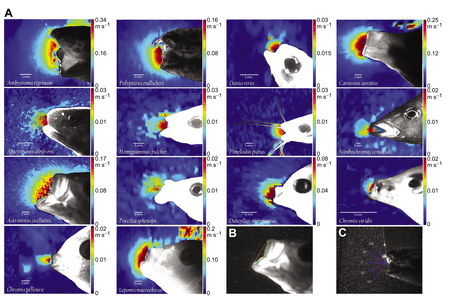
Suction feeding is a widespread prey capture strategy among aquatic vertebrates. It is almost omnipresent across fishes, and has repeatedly evolved in other aquatic vertebrates. By rapidly expanding the mouth cavity, suction feeders generate a fluid flow outside of their mouth, drawing prey inside. Fish and other suction-feeding organisms display remarkable trophic diversity, echoed in the diversity of their skull and mouth morphologies. Yet, it is unclear how variable suction flows are across species, and whether variation in suction flows supports trophic diversity. Using a high-speed flow visualization technique, we characterized the spatio-temporal patterns in the flow fields produced during feeding in 14 species of aquatic suction feeders. We found that suction-feeding hydrodynamics are highly conserved across species. Suction flows affected only a limited volume of ∼1 gape diameter away from the mouth, and peaked around the timing of maximal mouth opening. The magnitude of flow speed increased with increasing mouth diameter and, to a lesser extent, with decreasing time to peak gape opening. Other morphological, kinematic and behavioral variables played a minor role in shaping suction-feeding dynamics. We conclude that the trophic diversity within fishes, and likely other aquatic vertebrates, is not supported by a diversity of mechanisms that modify the characteristics of suction flow. Rather, we suggest that suction feeding supports such trophic diversity owing to the general lack of strong trade-offs with other mechanisms that contribute to prey capture.
Journal of Experimental Biology (2018)
DOI: 10.1242/jeb.174912
|
The Red Sea Simulator: A high‐precision climate change mesocosm with automated monitoring for the study of coral reef organisms
Jessica Bellworthy and Maoz Fine
Faculty of Life Sciences, Bar Ilan University, Israel
The Interuniversity Institute for Marine Sciences in Eilat, Israel
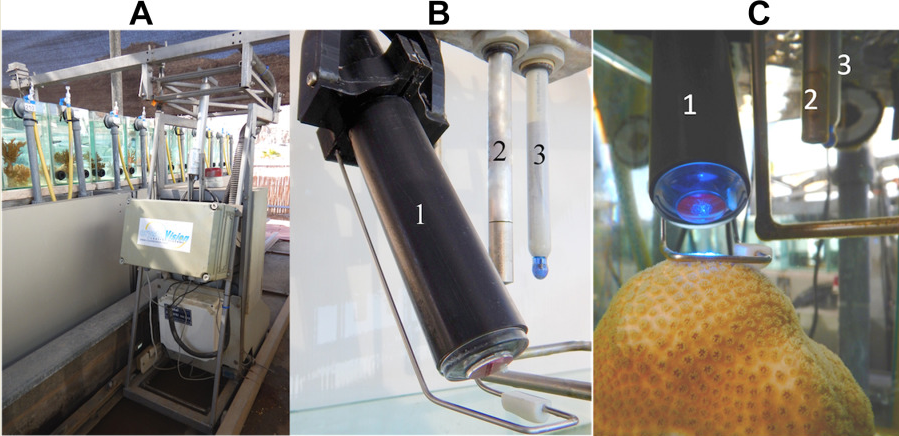
Experimental systems that enable the controlled perturbation of environmental parameters toward future scenarios are in high demand and becoming increasingly advanced. Herein, we describe the design and assess the performance of a large‐scale, flow‐through, mesocosm system. Located in the northern Gulf of Aqaba, the Red Sea simulator (RSS) was constructed in order to expose local coral reef organisms to future ocean scenarios. Seawater temperature and pH are typically set to a delta from incoming seawater readings and thus follow the diel range. This is achieved through automated monitoring (sensor‐carrying robot) and feedback system and a remote‐controlled user interface. Up to six different temperatures and four pH scenarios can be concomitantly operated in a total of 80 experimental aquaria. In addition, the RSS currently facilitates the manipulation of light intensity, light spectra, nutrient concentration, flow, and feeding regime. Monitoring data show that the system performs well; meeting the user‐defined environmental settings. A variety of reef organisms have been housed in the system for several months. Brooding reef building and soft coral species maintained in the simulator for many months have released planulae in synchrony with field colonies. This system boasts a high degree of replication, potential for multistressor manipulation, typical physiochemical environmental variability, and remotely controlled monitoring and data acquisition. These aspects greatly enhance our ability to make ecologically relevant performance assessments in a changing world.
|
Reproductive strategies of the coral Turbinaria reniformis in the northern Gulf of Aqaba (Red Sea)
Hanno Rapuano1, Itzchak Brickner1, Tom Shlesinger1, Efrat Meroz-Fine2, Raz Tamir1,2 & Yossi Loya1
1 Tel Aviv University
2 Interuniversity Institute for Marine Sciences in Eilat
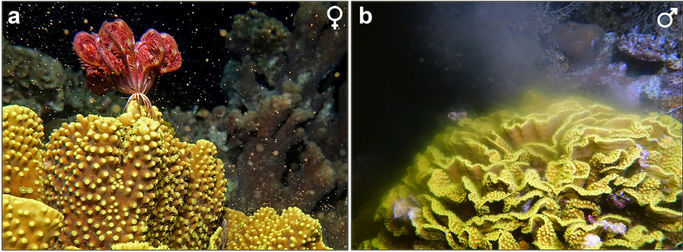
Here we describe for the first time the reproductive biology of the scleractinian coral Turbinaria reniformis studied during three years at the coral reefs of Eilat and Aqaba. We also investigated the possibility of sex change in individually tagged colonies followed over a period of 12 years. T. reniformis was found to be a stable gonochorist (no detected sex change) that reproduces by broadcast spawning 5–6 nights after the full moon of June and July. Spawning was highly synchronized between individuals in the field and in the lab. Reproduction of T. reniformis is temporally isolated from the times at which most other corals reproduce in Eilat. Its relatively long reproductive cycle compared to other hermaphroditic corals may be due to the high reproductive effort associated with the production of eggs by gonochoristic females. Sex ratio in both the Aqaba and Eilat coral populations deviated significantly from a 1:1 ratio. The larger number of males than of females may provide a compensation for sperm limitation due to its dilution in the water column. We posit that such sex allocation would facilitate adaptation within gonochoristic species by increasing fertilization success in low density populations, constituting a phenomenon possibly regulated by chemical communication.
Scientific Reports (2018): DOI:10.1038/srep42670
|
Auto-correlated directional swimming can enhance settlement success and connectivity in fish larvae
Igal Berenshteinabc, Claire Parisc, Hezi Gildord, Erick Fredje, Yael Amitaid, Omri Lapidotab & Moshe Kiflawibf
a Dept. of Life Sciences, Eilat Campus, Ben-Gurion University of the Negev
b The Interuniversity Institute for Marine Sciences of Eilat
c Rosenstiel School of Marine and Atmospheric Science, University of Miami, USA
d Institute of Earth Sciences, The Hebrew University, Jerusalem, Israel
e Dept. of Computer Science, Jerusalem Institute of Technology, Jerusalem, Israel
f Dept. of Life Sciences, Ben-Gurion University of the Negev, Beer-Sheva, Israel
|
Larvae of coastal-marine fishes have been shown repeatedly to swim directionally in the pelagic environment. Yet, biophysical models of larval dispersal typically impose a Simple Random Walk (SRW) algorithm to simulate non-directional movement in the open ocean. Here we investigate the use of a Correlated Random Walk (CRW) algorithm; imposing auto-correlated directional swimming onto simulated larvae within a high-resolution 3D biophysical model of the Gulf of Aqaba, the Red Sea. Our findings demonstrate that implementation of auto-correlated directional swimming can result in an increase of up to ×2.7 in the estimated success rate of larval-settlement, as well as an increase in the extent of connectivity. With accumulating empirical support for the capacity for directional-swimming during the pelagic phase, we propose that CRW should be applied in biophysical models of dispersal by coastal marine fish-larvae.
|
Quantitative species-level ecology of reef fish larvae via metabarcoding

Much of the ecology of coral-reef fish depends on a relatively short pelagic period, during which their tiny offspring (larvae) are found meandering far from the reef. Because of their diminutive size, quantitative studies of the circulating 'pool' of larvae, which can encompass tens if not hundreds of species, typically suffer from poor taxonomic resolution; seldom going down to the level of greatest ecological interest - the species. Using a novel molecular approach we have been able obtain the first, species-level quantification relative species abundances within a species-rich larval pool. With the data we addressed basic questions concerning the larval phase, which have not been accessible previously. For example: Do species differ in larval distribution across the water column, in a manner that may affect dispersal? Does the availability of larvae, in the plankton, affect the composition of local adult communities? And more... For answers, see https://www.nature.com/articles/s41559-017-0413-2 (see also https://www.ynet.co.il/articles/0,7340,L-5073900,00.html
|
Hydroid diversity of Eilat Bay with the description of a new Zanclea species
Daniela Pica1, Azzurra Bastari1, Claudia Francesca Vega1, Cristina Gioia Di Camillo1, Simone Montano2 and Stefania Puce1
1 Dipartimento di Sciernze della Vita e dell'Ambiente, Universita Politecnia delle Marche, Italy
2Dept. of Biotechnologies and Biosciences, University of Milano, Italy

Eilat Bay is located at the southernmost tip of Israel in the Gulf of Aqaba (Red Sea). The list of hydroids currently known from there includes 51 species, and when extending it to the entire Red Sea, it includes 157 species belonging to 41 families. Nevertheless, the information regarding hydroids in the Gulf of Aqaba, and in particular in Eilat Bay, is not exhaustive. The aim of this work is to improve knowledge of hydroid biodiversity in this area. The specimens collected during the HyDRa project (Hydroid Diversity of the Northern Red Sea) revealed the presence of 27 species, 13 Anthoathecata and 14 Leptothecata, belonging to 17 families and 20 genera. Two families, Cladonematidae and Corynidae, and five genera, Cladonema, Slabberia, Campanularia, Nemalecium and Lafoeina, are new findings for the Red Sea. Furthermore, Nemalecium lighti, Zanclea gallii and the new species Zanclea eilatensis sp. nov. have never before been recorded in the Red Sea. Zanclea eilatensis sp. nov. lives in association with a bryozoan, has a monomorphic colony lacking a perisarc and only has stenoteles in the polyps. The medusa stage has two prominent perradial exumbrellar nematocyst pouches and two tentacles with about 50 cnidophores having long flagella and containing macrobasic euryteles. In the present work, 54% of the species were associated with other organisms, such as hydroids, corals and bryozoans. New ecological data about the Zanclea–scleractinian coral association are documented. The present investigation provides new information about diversity in the Red Sea, and in particular in Eilat Bay. In addition, our data also have significance for Mediterranean and Red Sea biodiversity conservation due to the recent expansion of the Suez Canal and the consequent possible increase in the introduction of nonindigenous species in both directions.
|
Reproductive strategies of the coral Turbinaria reniformis in the northern Gulf of Aqaba (Red Sea)
Hanna Rapuano1, Itzchak Brickner1, Tom Shlesinger1, Efrat Meroz-Fine2, Raz Tamir1,2 &
Yossi Loya1
1Dept. of Zoology, The George S. Wise Faculty of Life Sciences, Tel-Aviv University
2The Interuniversity Institute for Marine Sciences in Eilat

Here we describe for the first time the reproductive biology of the scleractinian coral Turbinaria reniformis studied during three years at the coral reefs of Eilat and Aqaba. We also investigated the possibility of sex change in individually tagged colonies followed over a period of 12 years. T. reniformis was found to be a stable gonochorist (no detected sex change) that reproduces by broadcast spawning 5–6 nights after the full moon of June and July. Spawning was highly synchronized between individuals in the field and in the lab. Reproduction of T. reniformis is temporally isolated from the times at which most other corals reproduce in Eilat. Its relatively long reproductive cycle compared to other hermaphroditic corals may be due to the high reproductive effort associated with the production
of eggs by gonochoristic females. Sex ratio in both the Aqaba and Eilat coral populations deviated significantly from a 1:1 ratio. The larger number of males than of females may provide a compensation for sperm limitation due to its dilution in the water column. We posit that such sex allocation would facilitate adaptation within gonochoristic species by increasing fertilization success in low density populations, constituting a phenomenon possibly regulated by chemical communication.
|
Boxer crabs induce asexual reprod. of their assoc. sea anemones by splitting and intraspecific theft
Yisrael Schnytzer1, Yaniv Giman1, Ilan Karplus2 & Yair Achituv1
lFaculty of Life Sciences, Bar-Ilan University
2Institute of Animal Science, The Volcani Center
PeerJ: 2017: 5(e2954): DOI: 10.7717/peerj.2954

Crabs of the genus Lybia have the remarkable habit of holding a sea anemone in each of their claws. This partnership appears to be obligate, at least on the part of the crab. The present study focuses on Lybia leptochelis from the Red Sea holding anemones of the genus Alicia (family Aliciidae). These anemones have not been found free living, only in association with L. leptochelis. In an attempt to understand how the crabs acquire them, we conducted a series of behavioral experiments and molecular analyses. Laboratory observations showed that the removal of one anemone from a crab induces a “splitting” behavior, whereby the crab tears the remaining anemone into two similar parts, resulting in a complete anemone in each claw after regeneration. Furthermore, when two crabs, one holding anemones and one lacking them, are confronted, the crabs fight, almost always leading to the “theft” of a complete anemone or anemone fragment by the crab without them. Following this, crabs “split” their lone anemone into two. Individuals of Alicia sp. removed from freshly collected L. leptochelis were used for DNA analysis. By employing AFLP (Fluorescence Amplified Fragments Length Polymorphism) it was shown that each pair of anemones from a given crab is genetically identical. Furthermore, there is genetic identity between most pairs of anemone held by different crabs, with the others showing slight genetic differences. This is a unique case in which one animal induces asexual reproduction of another, consequently also affecting its genetic diversity.
|
Mechanical transgressive segregation and the rapid origin of trophic novelty

Roi Holzman1,2 and C. Darrin Husley3
1Tel Aviv University, Israel
2The Inter-University Institute for Marine Sciences in Eilat
3University of Konstanz, Germany
Sci. Reps. (2017) 7:40306. DOI: 10.1038/srep40306
Hybrid phenotypes are often intermediate between those of parental species. However, hybridization
can generate novel phenotypes when traits are complex. For instance, even when the morphologies
of individual musculo-skeletal components do not segregate outside the parental range in hybrid
offspring, complex functional systems can exhibit emergent phenotypes whose mechanics exceed
the parental values. To determine if transgression in mechanics could facilitate divergence during
an adaptive radiation, we examined three functional systems in the trophic apparatus of Lake
Malawi cichlid fishes. We conducted a simulation study of hybridization between species pairs whose
morphology for three functional systems was empirically measured, to determine how the evolutionary
divergence of parental species influences the frequency that hybridization could produce mechanics
that transgress the parental range. Our simulations suggest that the complex mechanical systems of
the cichlid trophic apparatus commonly exhibit greater transgression between more recently diverged
cichlid species. Because (1) all three mechanical systems produce hybrids with transgressive mechanics
in Lake Malawi cichlids, (2) hybridization is common, and (3) single hybrid crosses often recapitulate a
substantial diversity of mechanics, we conclude that mechanical transgressive segregation could play
an important role in the rapid accumulation of phenotypic variation in adaptive radiations.
|
Improving automated annotation of benthic survey images using wide-band fluorescence
1Dept. of Computer Science and Engineering, University of California
2Charney School of Marine Sciences, University of Haifa
3Integrative Oceanography Division, University of California
4The Interuniversity Institute for Marine Sciences in Eilat
5Dept. of Zoology, Tel Aviv University
6Global Change Institute, The University of Queensland, Brisbane
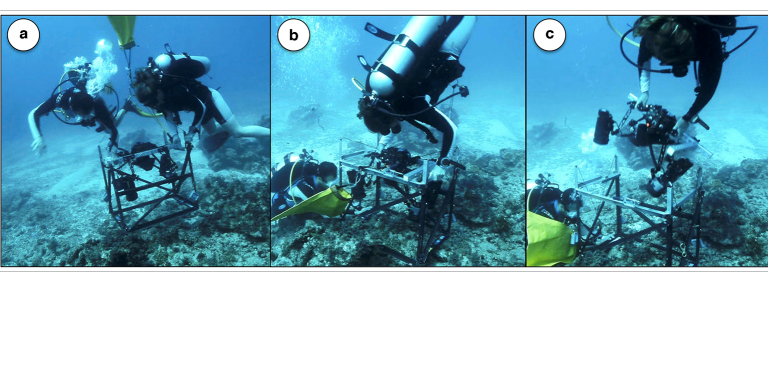
Abstract
Large-scale imaging techniques are used increasingly for ecological surveys. However, manual analysis can be prohibitively expensive, creating a bottleneck between collected images and desired data-products. This bottleneck is particularly severe for benthic surveys, where millions of images are obtained each year. Recent automated annotation methods may provide a solution, but reflectance images do not always contain sufficient information for adequate classification accuracy. In this work, the FluorIS, a low-cost modified consumer camera, was used to capture wide-band wide-field-of-view fluorescence images during a field deployment in Eilat, Israel. The fluorescence images were registered with standard reflectance images, and an automated annotation method based on convolutional neural networks was developed. Our results demonstrate a 22% reduction of classification error-rate when using both images types compared to only using reflectance images. The improvements were large, in particular, for coral reef genera Platygyra, Acropora and Millepora, where classification recall improved by 38%, 33%, and 41%, respectively. We conclude that convolutional neural networks can be used to combine reflectance and fluorescence imagery in order to significantly improve automated annotation accuracy and reduce the manual annotation bottleneck.
|
Effect of oxygen on coral fanning by mutualistic fish
Igal Berenshtein, Yaela Reuben and Amatzia Genin
The Interuniversity Institute of Eilat
|
Coral branches partially block the flow of water through the colony, creating an inner zone of reduced water exchange where hypoxic conditions can develop during the night. Previous studies have shown that this oxygen deficiency is alleviated by the fanning behavior of mutualistic damselfish that spend the night between the coral branches, constantly moving their fins. Our findings show that fin-stroking frequency during fanning by the damselfish Dascyllus marginatus is moderately plastic, with lower frequency under higher oxygen concentration, and vice versa. The inter-play between oxygen concentration and fin motion maintains nearly steady oxygen concentration between the coral branches during the night.
|
Superoxide in seawater may be produced by heterotrophic bacteria, with implications for trace metal cycling in the sea
Yeala Shaked and Andrew Rose
Interuniversity Institute for Marine Sciences in Eilat and Southern Cross University, Australia
|
In the past decade, sensitive analytical techniques have enabled a new look at the distributions, sources and chemical reactivity of superoxide (O2 −) in the ocean. Until recently superoxide was thought to form solely through photochemical reactions in the surface ocean, but now biological processes are considered to be equally important in generating superoxide. Diaz et al. (1) show that heterogeneous bacteria produce superoxide and potentially represent a substantial source of superoxide in the sea.
|
The Gulf of Eilat offers refugium for coral reefs in an era of climate change
Maoz Fine, Hezi Gildor and Amatzia Genin
Faculty of Life Sciences, Bar Ilan University; Dept. of Earth Sciences, The Hebrew University of Jerusalem and The Interuniversity Institute of Eilat

The stability and persistence of coral reefs in the decades to come is uncertain due to global warming and repeated
bleaching events that will lead to reduced resilience of these ecological and socio-economically important ecosystems.
Identifying key refugia is potentially important for future conservation actions. We suggest that the Gulf of Aqaba
(GoA) (Red Sea) may serve as a reef refugium due to a unique suite of environmental conditions. Our hypothesis is
based on experimental detection of an exceptionally high bleaching threshold of northern Red Sea corals and on the
potential dispersal of coral planulae larvae through a selective thermal barrier estimated using an ocean model. We
propose that millennia of natural selection in the form of a thermal barrier at the southernmost end of the Red Sea
have selected coral genotypes that are less susceptible to thermal stress in the northern Red Sea, delaying bleaching
events in the GoA by at least a century.
Stinging Cell Mechanism
Tamar Lotan
Marine Biology Department, The Leon H.Charney School of Marine Sciences, University of Haifa
The Cnidarians' (jellyfish, coral, sea anemone, hydra) stinging cells manufacture intracellular structures known as cnidocysts, cyst capsules, equipped with an injection system and act as biological syringes. These capsules contain highly folded thin tube resembling a needle and can hold pressure of 150 bar. Upon activation the tube unfolds and penetrates its target at a remarkable acceleration of 5•106g to deliver 10 times capsule volume through the needle. We have shown that isolated capsules can be used to actively deliver drug solutions to the skin. Since the mechanisms of both needle release and fluid injection are flow driven, we are studying flow and transport processes in these natural injectors. We are also interested in understanding the biological assembly of the capsule and its evolutionary origin.
Marine Fish Spill Their Guts - Calcium Carbonate Mineral Remains Uncrystallized in Fish Intestines
Ellie Foran, Maoz Fine
The Interuniversity Institute for Marine Sciences of Eilat and Faculty of Life Scieces, Bar Ilan University

A Scanning Electron Microscopy (SEM) image shows the composition of fish-gut pellets at a
microscopic level. Photo by E. Foran
Marine fish create a soft, disordered form of calcium carbonate (CaCO3) in their intestines, which easily dissolve when excreted in seawater. In a collaborative effort, scientists from Bar-Ilan University, the Interuniversity Institute of Marine Sciences in Eilat and the Weizmann Institute investigated some of the fundamental characteristics of calcium carbonate (CaCO3) minerals found in fish guts, which function as a reverse sponge for water absorption in the intestine. Results of the study, published in the journal Scientific Reports, revealed the piscine pellets analyzed were amorphous calcium carbonate (ACC), the most soluble of all CaCO3 forms. It was first suspected that the intestinal deposits were made up of something other than a crystalline structure, based on the malleable material, difference in pellet shape, and mucus covering. In addition, more and more ACC examples were being found among eclectic groups of organisms. So why not in fish guts? Experiments performed on the gilt-head seabream confirmed this hypothesis, also showing that the mineral remained in this soft, amorphous state throughout the intestinal tract. The researchers attribute the mineral’s stability, in part to the substantial incorporation of magnesium ions, originating from ingested seawater.
The extent of this stability was tested when fish carbonates were placed in seawater and monitored for dissolution. Rather than immediately crystallize, the pellets dissolved within an hour, nearly doubling the carbonate ion concentration in the surrounding water.
If fish regularly add very soluble carbonate to the sea, they may be important contributors to local environments, such as coral reefs, that use available carbonate to build skeletons.
Keep and Touch – cynaobacteria actively collect dust for utilizing its iron for growth
Yeala Shaked

Active centering of dust by puff-shaped natural Trichodesmium colonies, enabling them to dissolve and acquire iron from dust.
Iron is recognized as a major limiting element for marine primary producers and as such affects global carbon cycling and the world climate. Trichodesmium is a globally important marine N2 fixing cynobacterium that fuels other phytoplankton with new nitrogen sources. Trichodesmium has high requirement for iron but it resides in iron poor water. Dust deposited on the ocean surface was suggested as a possible source of iron for Trichodesmium. In a recent study published in Nature Geosciences (Rubin et al. 2011) we explored the sequence of steps by which natural and cultured Trichodesmium collect, process and utilize iron from synthetic iron oxides and desert dust. We discovered that Trichodesmium efficiently traps dust in its intricate colony morphology and that it can actively shuttle dust particles from the colony periphery to its core. This fascinating phenomenon enables it to keep the dust in the colony core and extract nutrient elements such as iron from the dust.
Dispersal of coral-reef fishes in the northern Gulf of Aqaba
Naama Kimmerling, Moshe Kiflawi
The Interuniversity Institute for Marine Sciences of Eilat and Ben Gurion University of the Negev
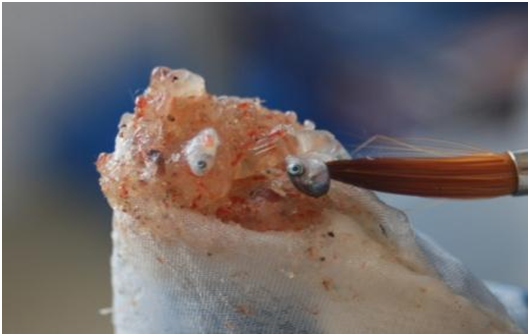
Photo: Meytal Markovich
The life-cycle of most coral-reef fish species consists of an adult stage, which is bound to a local reef, and a pelagic larval stage which is spent in the open sea. Dispersal in these fishes is limited to the larvae, making the pelagic stage a key demographic and ecological player. Our lab is currently focusing on two questions relating to the pelagic stage. First, using intensive field samples and biophysical models, we are trying to identify the factors that affect the spatial and temporal distribution of the larvae, and how it may ultimately affect dispersal trajectories in the Gulf of Eilat/Aqaba. Second, using in-situ experimentation, we are trying to uncover the orientation capabilities of these tiny larvae; with emphasis on their use of a sun compass.
Decision-making by cleaner-wrasse
Ofri Mann, Moshe Kiflawi
The Interuniversity Institute for Marine Sciences of Eilat and Ben Gurion University of the Negev
The text-book example of inter-specific mutualism must be the relationship between the cleaner wrasse and their clients; whereby clients benefit from having their ecto-parasites removed and the cleaners gain a meal. The system presents an interesting model for addressing questions related to the decision-making and market-dynamics (i.e. supply and demand). We are currently combining theoretical and field/lab work to examine optimal ‘cleaning-bout' durations for a cleaners operating either alone or as part of a cooperating pair.
Evidence for submesoscale barriers to horizontal mixing in the ocean from current measurements by HF radar
Hezi Gildor
The Fredy & Nadine Herrmann Institute of Earth Sciences at the Hebrew University Jerusalem, Israel
Numerous recent studies have investigated ocean mixing on mesoscales or larger scales using velocity fields derived from drifters, numerical models, and observations from satellites. These studies demonstrate the non-uniform characteristics of mixing and the existence of coherent structures.
Unlike these previous studies, we concentrate on the submesoscale (~1-20 km) motions leading to horizontal mixing. Accurate parameterizations of submesoscale mixing processes are critical in simulating and predicting ocean circulation and changes in the climate. Due to limited computer power, present day ocean and climate models resolve processes on scales down to a few tens of km. The combined effect of sub-grid processes, including different types of instabilities and waves, has to be parameterized, and this is typically done using diffusion-like parameterizations, with an “eddy diffusivity” which is larger than molecular diffusivity, but which implies similar physical characteristics to that of molecular diffusion. Two implications to using homogeneous (or even just smoothly varying) “eddy diffusivity” are that first, there are no barriers to mixing, and second, that the average absolute dispersion of particles (i.e. the average displacement of particles from their origins) grows in proportion to the square root of time. (Roughly speaking, by barrier we mean a line that separates regions with different mixing characteristics, and with little mixing across this line.)
Using a dataset of surface currents that collected in the Gulf of Eilat by HF radar, at an unprecedented combination of long duration (over four years) and high resolution (300 m), we have been investigating the horizontal mixing on the scale of a few km. Our study yielded important, unexpected results. We demonstrate, experimentally, the complexity of ocean mixing on such small scale and the existence of temporary barriers to mixing. This has important implications for the dispersion of pollutants, nutrients, larvae, etc., and therefore for a wide range of predictions. We were able to also verify the existence of these barriers for the first time by aerial-photographs (Figure 1). The existence of such barriers requires a new approach to the way mixing is parameterized in ocean and climate models.
 |
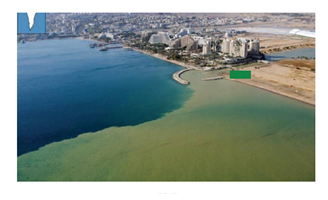 |
| Figure 1. Left: Relative dispersion in the Gulf of Eilat based on 36 hours of virtual particle tracking simulation using the measured HF radar surface velocities on February 3, 2006. The light-colored lines with higher relative dispersion values divide the domain into relatively well mixed regions, but little mixing occurs across these lines that therefore serve as barriers to mixing. Note the high relative dispersion line (between the red arrows) that starts in the western side of the northern coast and ends on the eastern coast. White areas are regions from which particles have moved out of the domain. Right: An aerial-photograph of the Gulf on Feb 5, after a flood washed sediments into the ocean. Note that the sediments do not mix across the same barrier line that was calculated from the currents observed by the HF radar and shown on the left. For orientation, note that the green rectangle both panels marks the same location. |
The great benefit of pulsation in soft corals
Amatzia Genin, Maya Kremien, Uri Shavit, and Tali Mass
The Interuniversity Institute for Marine Sciences and The Hebrew University of Jerusalem (AG, MK and TM) and The Technion, Israel Institute of Technology, Haifa (US)

The Xeniid coral Heteroxenia fuscescens during pulsation (A) and rest (B). Note the different postures of the tentacles among the pulsating polyps, demonstrating the absence of phase synchronization among the polyps within the colony. (C) - A schematic illustration of the stem and tentacles of a single polyp.
Soft corals of the family Xeniidae exhibit a unique, rhythmic pulsation of their tentacles (see http://piv.technion.ac.il/Research/Hetroxenia/Pulsating.mp4), first noted by Lamarck nearly 200 years ago. Yet, the adaptive benefit of this perpetual, energetically-costly motion is poorly understood. Using in-situ Underwater Particle Image Velocimetry we found that the pulsation motions thrust water upward and enhance mixing across the coral-water boundary layer. The induced upward motion effectively prevents re-filtration of water by neighboring polyps, while the intensification of mixing, together with the upward flow, greatly enhances the coral’s photosynthesis. A series of controlled laboratory experiments with the common xeniid coral Heteroxenia fuscesens showed that the net photosynthesis rate during pulsation was up to an order of magnitude higher than during the coral’s resting, non-pulsating state. This enhancement diminished when the concentration of oxygen in the ambient water was artificially raised, indicating that the enhancement of photosynthesis was due to a greater efflux of oxygen from the coral tissues. By lowering the internal oxygen concentration, pulsation alleviates the problem of reduced affinity of RuBisCO to CO2 under conditions of high oxygen concentrations. The photosynthesis-respiration ratio of the pulsating H. fuscesens was markedly higher than the ratios reported for non-pulsating soft and stony corals. While pulsation is commonly used for locomotion and filtration in marine mobile animals, its occurrence in sessile (bottom attached) species is limited to members of the ancient phylum Cnidaria, where is it used to accelerate water and enhance physiological processes.